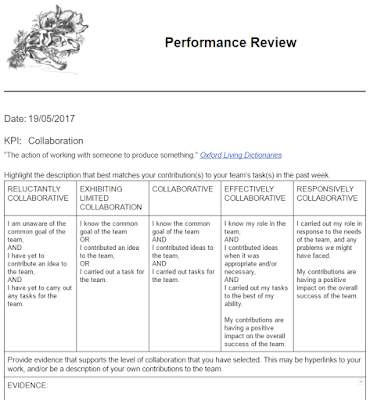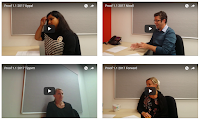Fraser, D., Aitken, V, & Whyte B. (2013) "Chapter Two: Curriculum Integration." Connecting Curriculum, Linking Learning. Wellington: NZCER
|
 This chapter was both affirming and challenging at the same time. It made me think about whether the learning opportunities we plan for and offer in Connected Learning are truly "curriculum integration" or simply "thematic units" that cater for as many Learning Areas as possible. For example, the latter would demand "fitting in" English, Science, Social Sciences, Mathematics and (for example) Drama into every aspect of the learning journey. The former would demand more student agency, leading to only demanding integration of the Learning Areas that are authentically applicable to the learning context. What we planned to do in Term Two with Mantle of the Expert (MOTE) was consistent with Curriculum Integration, but we ended up resorting back to more of a Thematic Unit after some challenges with the "building belief" phase of MOTE. What we have planned for Term Three should be more successful as true Curriculum Integration.
This chapter was both affirming and challenging at the same time. It made me think about whether the learning opportunities we plan for and offer in Connected Learning are truly "curriculum integration" or simply "thematic units" that cater for as many Learning Areas as possible. For example, the latter would demand "fitting in" English, Science, Social Sciences, Mathematics and (for example) Drama into every aspect of the learning journey. The former would demand more student agency, leading to only demanding integration of the Learning Areas that are authentically applicable to the learning context. What we planned to do in Term Two with Mantle of the Expert (MOTE) was consistent with Curriculum Integration, but we ended up resorting back to more of a Thematic Unit after some challenges with the "building belief" phase of MOTE. What we have planned for Term Three should be more successful as true Curriculum Integration.I have come to the conclusion that I advocate more strongly for Connected Learning being Curriculum Integration rather than Thematic Learning. There are a few reasons, primarily based upon a statement in p16 of The New Zealand Curriculum: "All learning should make use of the natural connections that exist between learning areas." The word "natural" is important here. Inclusion of certain Learning Areas into thematic units can feel contrived at times. While some Learning Areas may get less explicit "coverage" this way, I put more value in the potential for the depth of cross-curricular, authentic learning that can occur in true curriculum integration.
Curriculum Integration in Connected Learning will need to see us include some key steps that I will quote directly from the chapter:
- "Negotiating the curriculum." Students take a role "in co-planning, exploring and evaluating" their chosen inquiries or contexts. In our plan for Term three, this is explicit as learners explore a social action they will be challenged to actually carry out. We are limiting it within a parameter, but it is wide-reaching: "Think Globally, Act Locally."
- "Issues driven rather than topic driven." Term Three is about Planet Earth. That is a broad enough theme to allow for this. As mentioned above, we are focusing upon a social action, so the learning (and action) will definitely be issue driven.
- "Scaffolding [of] student' learning rather than directing them." We are already looking at using SOLO Taxonomy, Design Processes (Technology Learning Area) and Investigating (Science Learning Area) to help with such scaffolding. Why reinvent the wheel...?
- "Only draws upon learning areas that relate to the central issues of the inquiry." This feels uncomfortable at first, to be honest. We have yet to explore geometry in any depth, and I expect few inquiries will have need for geometry in Term Three. However, we have to remember that we are viewing Connected Learning as an eight term learning journey. There will be times when every critical element of the explicitly-included Learning Areas will be explored. We are spending a few weeks to explore some aspects of "Planet Earth" as a theme, and hope that these inspire learners to come up with authentic social actions that they can actually succeed in. Once they choose (and negotiate) their issue and inquiry, only the Learning Areas that are related will be explored.
"We are only kids. Nobody cares what we think."
It was one of those moments when my heart sunk, but it also sparked a great conversation and I explained to her (then later to the class) that we were going to help them see that they did indeed have the potential to make a real difference to their own community, region, country and/or planet. They were going to be challenged to matter.
This chapter made another statement that helped affirm that we are doing the right thing by aiming to do the right thing by our learners:
"Negotiating curriculum...has been recognised as an approach that caters for the learning needs of Māori students in secondary schools."
In my experience, whatever works well for Māori learners has positive outcomes for all learners. I have also noticed that empowering learners as decision makers results in higher engagement and better learning outcomes for all learners.
It was great to read a text that affirmed and challenged the direction we are hoping to take the learning in Connected Learning in Term Three and beyond.
My Further (Future) Reading:
Bishop, P. A. & Berryman, M. (2009). The Te Kotahitanga effective teaching profile. Set: Research Information for Teachers, 2, 27-34
Drake, S. M. (1998) Creating integrated curriculum: Proven ways to increase student learning. Thousand Oaks, CA: Corwin Press
Drake, S. M. & Burns, R. C. (2004) Meeting standards through integrated curriculum. Alexandria, VA: Association for Supervision and Curriculum Development












